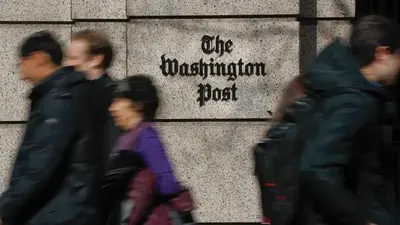Business
Housing advocates forecasted the 2008 financial crisis, they said they were ignored
Four years before Lehman Brothers collapsed and set off the worst U.S. financial disaster since the Great Depression, Ruhi Maker warned top officials at the Federal Reserve that the nation's housing bubble could wreak "enormous" economic damage.
Maker, a housing attorney in Rochester, New York, told Fed officials that a flood of faulty home loans could imperil the soundness of major investment banks, even naming Lehman Brothers, according to a transcript of the meeting.
The testimony drew on experience at the frontlines of a foreclosure crisis fueled by subprime loans thrust upon borrowers who couldn't afford them, Maker told ABC News.
"I remember one woman, a widow, sitting across from me and crying. She said she was so happy her husband had died, so he couldn't see what a mess she had made of the house," Maker said.
This fall marks the 15th anniversary of the onset of the 2008 financial crisis, which quickly spiraled into the Great Recession. In short order, millions lost their homes and the U.S. unemployment rate climbed to 10%.
MORE: A look back at the Lehman Brothers collapse, and the global crisis that followed: Reporter's notebook
Over the years since, a group of Wall Street traders became famous for anticipating the downturn and parlaying that insight into a massive payoff, as depicted in the book from best-selling author Michael Lewis, "The Big Short," which was later adapted into a star-studded film.
But a lesser-known group of housing attorneys, consumer advocates and academics for years warned that the housing market stood a severe risk of going belly up and would bring economic catastrophe if it did.
"When it started to be this story that a bunch of smart people on Wall Street realized that investors were making money off of poor people and the structures were going to collapse, it felt like we had been singing a song that they had been listening to," Kathleen Engel, a professor at Suffolk University Law School who authored research about the housing crisis in the early 2000s, told ABC News.
"They didn't go out and meet with people and the Fed and say, 'Look, this is about to crash," Engel added.
Lewis did not immediately respond to ABC News' request for comment.
As attorneys defending tenants and academics examining real estate trends, a small group of experts examining the housing market at the turn of the century noticed an uptick in loans made to low-income borrowers, or subprime loans.
The share of mortgages made up by subprime loans rose dramatically at the start of the 2000s, from about 7% in 2001 to 23% in 2006, Inside Mortgage Finance data shows.
Many of the loans were adjustable-rate mortgages, meaning that the interest payments started low in the initial years but later spiked, leaving low-income borrowers unable to afford their homes and triggering widespread defaults, Michael Calhoun, president of the Center for Responsible Lending, told ABC News
"Those who were working with people at the street level knew there was this foreclosure crisis bubbling," Calhoun said. "We knew the subprime market would totally collapse. We saw a tidal wave out there."
At meetings with Fed officials in the early and mid 2000s, housing experts warned of an impending downturn and urged the Fed to take action, meeting transcripts show. Among the Fed officials in attendance was Ben Bernanke, who went on to lead the Fed through the financial crisis.
At a meeting with Fed officials in 2004, Maker warned of a potential housing market collapse with "enormous economic impact," tracing the lending to investment banks like Bear Stearns and Lehman Brothers. "Right now there's money to be made in not doing due diligence," Maker said, calling for bolstered government regulation of the banks.
Two years later, Alan White, then the supervising attorney at Community Legal Services in Philadelphia, warned Fed officials of a "huge increase in foreclosures" posing a risk that "isn't well understood, I don't think, by consumer or capital markets," according to a meeting transcript.
At the same meeting, in 2006, Carolyn Carter urged the Fed to "prohibit abuses in the mortgage market," the transcript shows.

Over the months leading up to the financial crisis, the warnings became more dire. In 2007, Stella Adams, then the executive director of the North Carolina Fair Housing Center, raised an alarm on behalf of attorneys and advocates who worked with at-risk tenants.
"For some of us on the consumer side, we feel like we are canaries in a coal mine, and that we said to the folks, this was going on and the canary has died. But the miners were sent in anyway," Adams told Fed officials, according to a meeting transcript.
The critics felt ignored by the Fed and fearful of where the U.S. economy was headed, according to several who appeared at the meetings and spoke with ABC News. But they drew support from each other, they added.
"It was like witnessing a lie that all was well," Hattie Dorsey, then the president and CEO of Atlanta Neighborhood Development, told ABC News.
"There were a lot of feelings: anger, frustration, feelings of being stepped on," Engel said. "We realized we were very lonely. Everybody was having their own experiences in different parts of the country."
Maker, the Rochester housing attorney, said: "We were seeing the patterns in different states and knew it was coming from somewhere at the top."
In September 2008, Lehman Brothers declared bankruptcy, setting off a cascade of bank failures. A month later, Congress passed a $700 billion bailout program for major banks, including Bear Stearns.
MORE: Is this a banking crisis? What to know about the Silicon Valley Bank collapse
The following year, the net worth of U.S. households stood $16.4 trillion lower than it did before the crisis, largely due to lost home value and damaged retirement accounts, Federal Reserve data showed.
Lewis's book, "The Big Short," mentions housing advocates on the frontlines of the foreclosure crisis but largely focuses on Wall Street traders who anticipated the real estate collapse.
Calhoun, of the Center for Responsible Lending, said he spoke with Lewis for the book. "We're in a footnote," Calhoun said.
The alarms raised by housing advocates are detailed, however, in the 532-page report that was ordered by Congress in the aftermath of the collapse.
At an event announcing the release of the report, in 2010, Phil Angelides, the chairman of the commission behind it, emphasized the importance of remembering those who warned government officials of the impending collapse.
"The greatest tragedy would be to accept the idea that no one could have seen this crisis coming and thus, nothing could have been done," Angelides said. "If we accept this notion, it will happen again."
-

 Business10h ago
Business10h agoMaster Cross-Border E-Commerce Transactions and VAT
-

 Business10h ago
Business10h agoUnderstanding the Significance of Business Accountancy
-

 Business14h ago
Business14h agoWhy being humble can make you a better leader
-

 Business17h ago
Business17h agoAlexandre Bonvin and Audacia Group’s Rise to Prominence
-

 Business17h ago
Business17h agoLocked and Secure: Understanding the Vitality of Physical Security
-

 Business19h ago
Business19h agoNestlé Adds Sugar to Baby Milk and Cereal in Poorer Nations, Report Finds
-

 Business1d ago
Business1d agoAllegations of Mismanagement and Market Manipulation Plague Lottery.com Inc.: Shareholders Demand Accountability
-

 Business1d ago
Business1d agoWhat’s the Deal With the Bitcoin Halving?



























